外文翻译:公路工程变更原因分析及其对工程造价的影响
- 格式:doc
- 大小:41.50 KB
- 文档页数:5
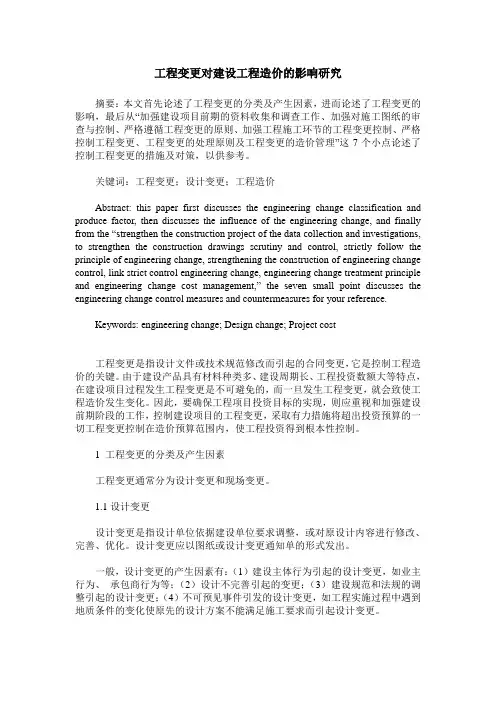
工程变更对建设工程造价的影响研究摘要:本文首先论述了工程变更的分类及产生因素,进而论述了工程变更的影响,最后从“加强建设项目前期的资料收集和调查工作、加强对施工图纸的审查与控制、严格遵循工程变更的原则、加强工程施工环节的工程变更控制、严格控制工程变更、工程变更的处理原则及工程变更的造价管理”这7个小点论述了控制工程变更的措施及对策,以供参考。
关键词:工程变更;设计变更;工程造价Abstract: this paper first discusses the engineering change classification and produce factor, then discusses the influence of the engineering change, and finally from the “strengthen the construction project of the data collection and investigations, to strengthen the construction drawings scrutiny and control, strictly follow the principle of engineering change, strengthening the construction of engineering change control, link strict control engineering change, engineering change treatment principle and engineering change cost management,” the seven small point di scusses the engineering change control measures and countermeasures for your reference.Keywords: engineering change; Design change; Project cost工程变更是指设计文件或技术规范修改而引起的合同变更,它是控制工程造价的关键。
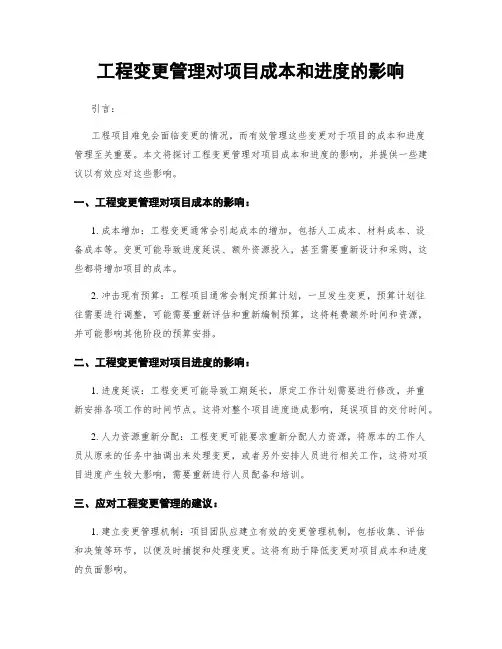
工程变更管理对项目成本和进度的影响引言:工程项目难免会面临变更的情况,而有效管理这些变更对于项目的成本和进度管理至关重要。
本文将探讨工程变更管理对项目成本和进度的影响,并提供一些建议以有效应对这些影响。
一、工程变更管理对项目成本的影响:1. 成本增加:工程变更通常会引起成本的增加,包括人工成本、材料成本、设备成本等。
变更可能导致进度延误、额外资源投入,甚至需要重新设计和采购,这些都将增加项目的成本。
2. 冲击现有预算:工程项目通常会制定预算计划,一旦发生变更,预算计划往往需要进行调整,可能需要重新评估和重新编制预算,这将耗费额外时间和资源,并可能影响其他阶段的预算安排。
二、工程变更管理对项目进度的影响:1. 进度延误:工程变更可能导致工期延长,原定工作计划需要进行修改,并重新安排各项工作的时间节点。
这将对整个项目进度造成影响,延误项目的交付时间。
2. 人力资源重新分配:工程变更可能要求重新分配人力资源,将原本的工作人员从原来的任务中抽调出来处理变更,或者另外安排人员进行相关工作,这将对项目进度产生较大影响,需要重新进行人员配备和培训。
三、应对工程变更管理的建议:1. 建立变更管理机制:项目团队应建立有效的变更管理机制,包括收集、评估和决策等环节,以便及时捕捉和处理变更。
这将有助于降低变更对项目成本和进度的负面影响。
2. 变更评估与控制:对于已经发生的变更,项目团队应进行全面的评估与控制,包括变更的必要性、影响范围、成本估算、工期安排等,以便做出明智的决策和合理的调整。
3. 沟通与协调:在处理工程变更时,及时、清晰地沟通与协调各方利益,确保各方对变更的理解和共识。
高效的沟通与协调有助于减少误解和冲突,提升变更管理工作的效果。
4. 变更预留:在项目计划和预算中合理预留一定的变更空间,以应对可能发生的变更。
这将有助于降低变更对项目成本和进度的不可预测性,使变更管理工作更加可控。
5. 资源优化与整合:合理优化和整合项目资源,以提高项目变更管理的效率和灵活性。
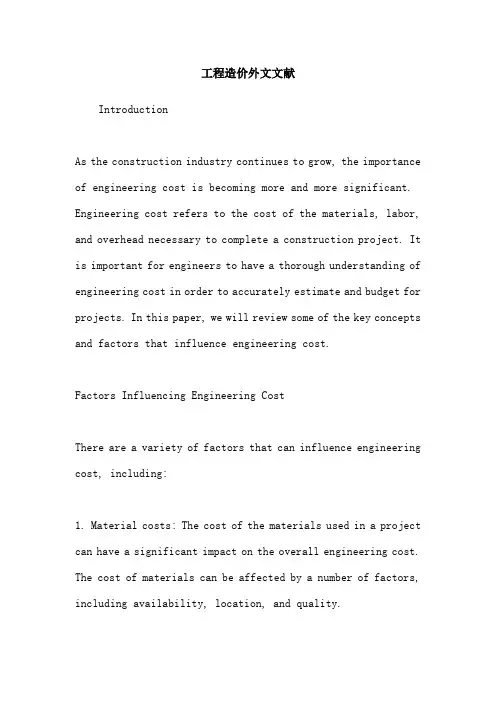
工程造价外文文献IntroductionAs the construction industry continues to grow, the importance of engineering cost is becoming more and more significant. Engineering cost refers to the cost of the materials, labor, and overhead necessary to complete a construction project. It is important for engineers to have a thorough understanding of engineering cost in order to accurately estimate and budget for projects. In this paper, we will review some of the key concepts and factors that influence engineering cost.Factors Influencing Engineering CostThere are a variety of factors that can influence engineering cost, including:1. Material costs: The cost of the materials used in a project can have a significant impact on the overall engineering cost. The cost of materials can be affected by a number of factors, including availability, location, and quality.2. Labor costs: The cost of labor is another key factor in engineering cost. Labor costs can be influenced by the level of expertise required for the project, as well as the location and availability of labor.3. Overhead costs: Overhead costs include expenses such as rent, utilities, and insurance. These costs can vary depending on the size and location of the project.4. Design complexity: The complexity of the project design can also impact engineering cost. More complex designs may require specialized materials and labor, which can increase costs.5. Project location: The location of the project can also impact engineering cost. Projects in urban areas may have higher labor and material costs, while projects in rural areas may have higher transportation costs.6. Timefra The timeframe for completing a project can also influence engineering cost. Projects that need to be completed quickly may require additional labor and materials, which can increase costs.ConclusionEngineering cost is an important factor to consider when planning and budgeting for construction projects. By understanding the key factors that can influence engineering cost, engineers can develop more accurate estimates and budgets. Additionally, by monitoring engineering cost throughout the project, engineers can identify potential cost overruns and take corrective action to keep the project on track.。
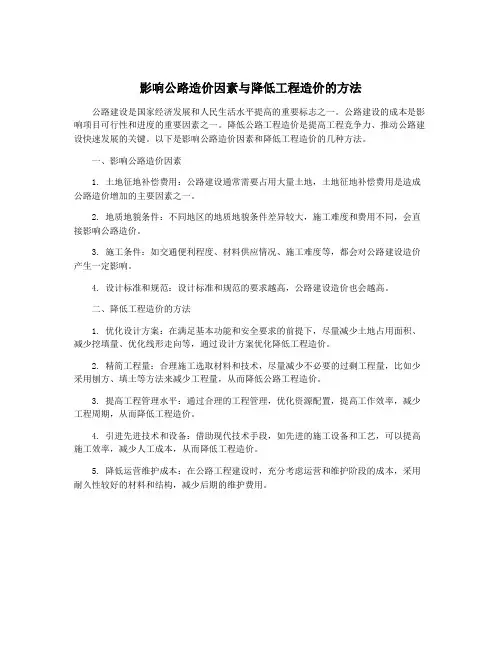
影响公路造价因素与降低工程造价的方法
公路建设是国家经济发展和人民生活水平提高的重要标志之一。
公路建设的成本是影响项目可行性和进度的重要因素之一。
降低公路工程造价是提高工程竞争力、推动公路建设快速发展的关键。
以下是影响公路造价因素和降低工程造价的几种方法。
一、影响公路造价因素
1. 土地征地补偿费用:公路建设通常需要占用大量土地,土地征地补偿费用是造成公路造价增加的主要因素之一。
2. 地质地貌条件:不同地区的地质地貌条件差异较大,施工难度和费用不同,会直接影响公路造价。
3. 施工条件:如交通便利程度、材料供应情况、施工难度等,都会对公路建设造价产生一定影响。
4. 设计标准和规范:设计标准和规范的要求越高,公路建设造价也会越高。
二、降低工程造价的方法
1. 优化设计方案:在满足基本功能和安全要求的前提下,尽量减少土地占用面积、减少挖填量、优化线形走向等,通过设计方案优化降低工程造价。
2. 精简工程量:合理施工选取材料和技术,尽量减少不必要的过剩工程量,比如少采用刨方、填土等方法来减少工程量,从而降低公路工程造价。
3. 提高工程管理水平:通过合理的工程管理,优化资源配置,提高工作效率,减少工程周期,从而降低工程造价。
4. 引进先进技术和设备:借助现代技术手段,如先进的施工设备和工艺,可以提高施工效率,减少人工成本,从而降低工程造价。
5. 降低运营维护成本:在公路工程建设时,充分考虑运营和维护阶段的成本,采用耐久性较好的材料和结构,减少后期的维护费用。
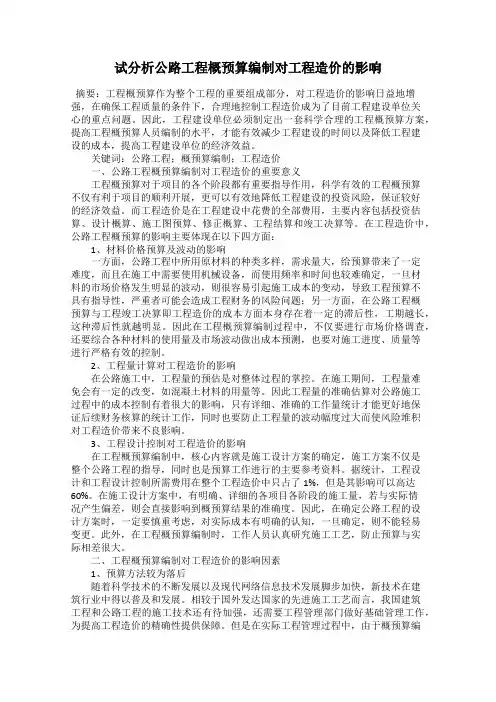
试分析公路工程概预算编制对工程造价的影响摘要:工程概预算作为整个工程的重要组成部分,对工程造价的影响日益地增强,在确保工程质量的条件下,合理地控制工程造价成为了目前工程建设单位关心的重点问题。
因此,工程建设单位必须制定出一套科学合理的工程概预算方案,提高工程概预算人员编制的水平,才能有效减少工程建设的时间以及降低工程建设的成本,提高工程建设单位的经济效益。
关键词:公路工程;概预算编制;工程造价一、公路工程概预算编制对工程造价的重要意义工程概预算对于项目的各个阶段都有重要指导作用,科学有效的工程概预算不仅有利于项目的顺利开展,更可以有效地降低工程建设的投资风险,保证较好的经济效益。
而工程造价是在工程建设中花费的全部费用,主要内容包括投资估算、设计概算、施工图预算、修正概算、工程结算和竣工决算等。
在工程造价中,公路工程概预算的影响主要体现在以下四方面:1、材料价格预算及波动的影响一方面,公路工程中所用原材料的种类多样,需求量大,给预算带来了一定难度,而且在施工中需要使用机械设备,而使用频率和时间也较难确定,一旦材料的市场价格发生明显的波动,则很容易引起施工成本的变动,导致工程预算不具有指导性,严重者可能会造成工程财务的风险问题;另一方面,在公路工程概预算与工程竣工决算即工程造价的成本方面本身存在着一定的滞后性,工期越长,这种滞后性就越明显。
因此在工程概预算编制过程中,不仅要进行市场价格调查,还要综合各种材料的使用量及市场波动做出成本预测,也要对施工进度、质量等进行严格有效的控制。
2、工程量计算对工程造价的影响在公路施工中,工程量的预估是对整体过程的掌控。
在施工期间,工程量难免会有一定的改变,如混凝土材料的用量等。
因此工程量的准确估算对公路施工过程中的成本控制有着很大的影响,只有详细、准确的工作量统计才能更好地保证后续财务核算的统计工作,同时也要防止工程量的波动幅度过大而使风险堆积对工程造价带来不良影响。
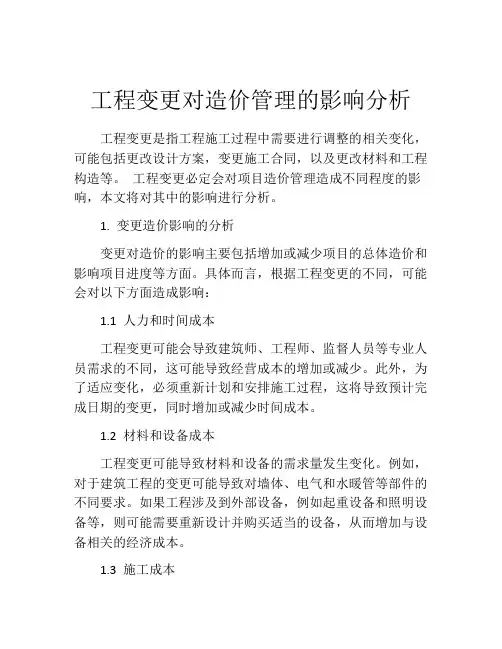
工程变更对造价管理的影响分析工程变更是指工程施工过程中需要进行调整的相关变化,可能包括更改设计方案,变更施工合同,以及更改材料和工程构造等。
工程变更必定会对项目造价管理造成不同程度的影响,本文将对其中的影响进行分析。
1. 变更造价影响的分析变更对造价的影响主要包括增加或减少项目的总体造价和影响项目进度等方面。
具体而言,根据工程变更的不同,可能会对以下方面造成影响:1.1 人力和时间成本工程变更可能会导致建筑师、工程师、监督人员等专业人员需求的不同,这可能导致经营成本的增加或减少。
此外,为了适应变化,必须重新计划和安排施工过程,这将导致预计完成日期的变更,同时增加或减少时间成本。
1.2 材料和设备成本工程变更可能导致材料和设备的需求量发生变化。
例如,对于建筑工程的变更可能导致对墙体、电气和水暖管等部件的不同要求。
如果工程涉及到外部设备,例如起重设备和照明设备等,则可能需要重新设计并购买适当的设备,从而增加与设备相关的经济成本。
1.3 施工成本施工成本包括项目直接与施工相关的费用,例如劳动力成本和建筑材料的费用。
工程变更会导致一系列施工过程的调整,需要对施工流程进行重新设计和规划。
这可能导致施工成本的增加或减少。
1.4 效益影响工程变更可能对工程的效益产生影响,从而影响管理成本。
例如,如果变更会影响工程的安全性、持续性或使用寿命等,则必须对这些方面进行重新评估,可能需要对工程进行调整或重新设计。
这将导致工程管理成本的增加。
2. 变更控制措施2.1 控制变更的数量和频率首先应该尽力控制变更的数量和频率。
在变更发生之前,应该对计划进行充分的研究和准备,并通过加强管理,能力和沟通等手段尽可能减少变更的可能性。
如果变化必须进行,则应根据合同规定对变化进行控制。
2.2 控制变更的影响如果变更是必须进行的,则应在变更控制过程中采取相应的措施来弥补造价和进度影响。
其中,如果可能的话,应当通过采用更好的管理方法或技术来尽可能减少影响,否则必须进行合理的商业协商以拟定适当的改变协议。
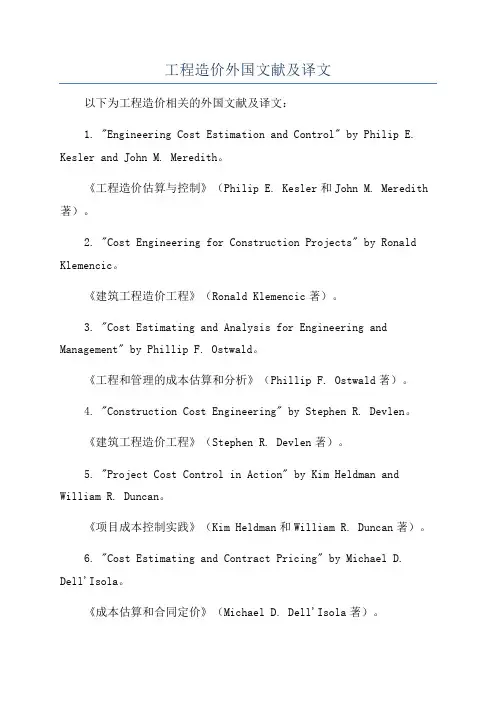
工程造价外国文献及译文以下为工程造价相关的外国文献及译文:1. "Engineering Cost Estimation and Control" by Philip E. Kesler and John M. Meredith。
《工程造价估算与控制》(Philip E. Kesler和John M. Meredith 著)。
2. "Cost Engineering for Construction Projects" by Ronald Klemencic。
《建筑工程造价工程》(Ronald Klemencic著)。
3. "Cost Estimating and Analysis for Engineering and Management" by Phillip F. Ostwald。
《工程和管理的成本估算和分析》(Phillip F. Ostwald著)。
4. "Construction Cost Engineering" by Stephen R. Devlen。
《建筑工程造价工程》(Stephen R. Devlen著)。
5. "Project Cost Control in Action" by Kim Heldman and William R. Duncan。
《项目成本控制实践》(Kim Heldman和William R. Duncan著)。
6. "Cost Estimating and Contract Pricing" by Michael D. Dell'Isola。
《成本估算和合同定价》(Michael D. Dell'Isola著)。
7. "Engineering Economics and Economic Design for Process Engineers" by Thane Brown。

论设计变更对工程造价的影响及控制随着工程建设项目的逐步推进,设计变更成为不可避免的问题之一。
设计变更直接影响着工程造价的控制和管理,并给工程项目的进度与质量带来挑战。
因此,论设计变更对工程造价的影响及控制显得尤为重要。
一、设计变更对工程造价的影响1.增加工程成本:在工程施工过程中,设计变更意味着重新设计、购置设备、调整材料和人力等种种额外成本。
无论是在建筑、结构还是机电等领域,设计变更都会对工程制造、建筑物内外装修、设备购置、配套服务等方面造成额外费用负担,从而大量增加工程成本,增大项目的风险。
2.影响工程进度:传统设计变更需要对原有的设计方案重新审查,而且审查时间可能较长,由此不可避免地会影响工程进度和交付期限。
设计变更,尤其是繁琐的设计变更,也会导致现场生产和质量难以保证,甚至加剧质量管理难度。
因此,设计变更对工程进度的影响不能忽视。
3.影响工程质量:设计在工程质量管理中起着至关重要的作用。
设计变更对工程质量也会带来影响。
如果设计变更不当,则可能导致工程结构不牢固、设备或材料配合不合适、地基软弱、土地稳定性差等问题。
这些问题可能导致工程质量不达标,甚至危及工程安全。
二、控制设计变更对工程造价的影响1.改善设计变更管理:首先,必须改善设计变更的管理,以减少其对工程造价和工程实施的影响。
建立完善的管理机制,例如指定专人负责管理设计变更和审核其合理性,以便加快工程进度并最大限度地减少额外成本。
2.加强设计变更与合同管理:其次,我们必须加强设计变更与合同管理。
在制定合同时,必须对潜在的设计变更做出逐一分析。
合同管理应制定详细的设计规范,并禁止未经设计人员授权的随意更改设计方案。
设计变更必须经过合同的修改和签字才能被执行。
3.时刻保持沟通:沟通是设计变更管理的关键。
如果您是项目经理或相关的人员,那么与设计师和建筑师等的沟通有助于更加全面地理解设计方案。
合格的专业团队和双方良好的沟通可以及时解决设计问题,减少设计变更的发生并保证工程的顺利进行。

工程变更对造价的影响在工程项目实施过程中,难免会出现工程变更的情况。
工程变更是指在项目实施过程中,由于各种原因需要进行对原定方案或设计进行修改或调整的情况。
而这些工程变更往往会对项目造价产生一定的影响。
本文将探讨工程变更对造价的影响,并对其中的主要因素进行分析。
一、设计变更的造价影响设计变更是工程变更中最常见的形式。
在设计阶段,项目方往往会根据实际情况对原始设计进行修改,以满足项目需求的变化。
例如,在建筑设计中,如果原本规划为商业使用的建筑需要转变为住宅使用,那么就需要对设计进行相应的调整。
设计变更对造价的影响主要体现在以下几个方面:1. 材料成本变化:设计变更通常会伴随着材料的选择变化,因此材料成本也会发生相应的变化。
有些情况下,新的设计可能需要更高成本的材料,从而导致整体造价上升。
2. 施工工艺调整:设计变更可能涉及到施工方面的调整,例如安装位置的变化、施工工艺的调整等。
这些调整可能会引起人工成本的增加或减少,从而影响到项目的造价。
3. 设备设施变动:设计变更可能需要对项目中的一些设备设施进行重新选择或修改。
不同的设备设施选型和规模通常会导致造价的差异。
4. 工程量变更:设计变更还可能会对工程量产生影响,例如增加了某些构件或减少了某些构件的数量。
工程量的变化必然会导致成本的变动。
二、合同变更的造价影响除了设计变更外,合同变更也是工程变更中常见的形式之一。
合同变更是指在项目施工过程中,双方合同上约定的内容需进行调整或修改的情况。
合同变更对造价的影响主要体现在以下几个方面:1. 合同价格调整:合同变更可能会导致项目的工作量、工程质量、工作条件等发生变化,从而需要对合同价格进行重新调整。
例如,在施工过程中发现原先未预料到的困难,需要增加工期或者增加某些工作的投入,这时就需要对合同价格进行相应的调整。
2. 双方权益重新分配:合同的变更可能会影响到双方的权益分配,例如工程变更可能导致某个环节的责任发生变化,从而需要重新进行商定并修改合同条款。
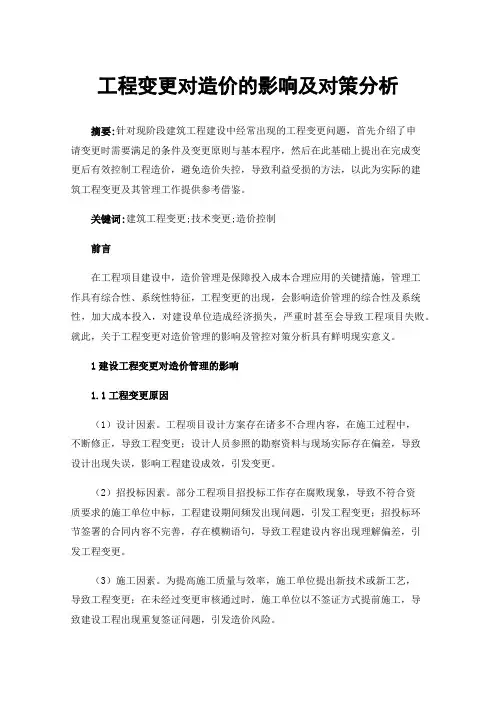
工程变更对造价的影响及对策分析摘要:针对现阶段建筑工程建设中经常出现的工程变更问题,首先介绍了申请变更时需要满足的条件及变更原则与基本程序,然后在此基础上提出在完成变更后有效控制工程造价,避免造价失控,导致利益受损的方法,以此为实际的建筑工程变更及其管理工作提供参考借鉴。
关键词:建筑工程变更;技术变更;造价控制前言在工程项目建设中,造价管理是保障投入成本合理应用的关键措施,管理工作具有综合性、系统性特征,工程变更的出现,会影响造价管理的综合性及系统性,加大成本投入,对建设单位造成经济损失,严重时甚至会导致工程项目失败。
就此,关于工程变更对造价管理的影响及管控对策分析具有鲜明现实意义。
1建设工程变更对造价管理的影响1.1工程变更原因(1)设计因素。
工程项目设计方案存在诸多不合理内容,在施工过程中,不断修正,导致工程变更;设计人员参照的勘察资料与现场实际存在偏差,导致设计出现失误,影响工程建设成效,引发变更。
(2)招投标因素。
部分工程项目招投标工作存在腐败现象,导致不符合资质要求的施工单位中标,工程建设期间频发出现问题,引发工程变更;招投标环节签署的合同内容不完善,存在模糊语句,导致工程建设内容出现理解偏差,引发工程变更。
(3)施工因素。
为提高施工质量与效率,施工单位提出新技术或新工艺,导致工程变更;在未经过变更审核通过时,施工单位以不签证方式提前施工,导致建设工程出现重复签证问题,引发造价风险。
(4)其他因素。
在工程项目建设中,自然条件变化,也会导致工程变更,如地震、降雨、大雾等,影响原本施工计划,不得不进行工程变更;建设单位需求变化,在工程项目投入建设后,建设单位对工程项目的需求可能出现变化,导致工程设计与施工均随之改变,引发工程变更。
1.2造价管理风险基于上述因素,建设工程在出现工程变更后,使施工方案、施工材料与设备需求、施工人员配置出现变化,导致工程项目的资源投入与费用支出出现变化,进而引发造价管理风险。

工程造价毕业论文外文文献————————————————————————————————作者:————————————————————————————————日期:外文文献:Construction Standards and CostsUC Irvine new construction pursues performance goals and applies quality standards that affect the costs of capital projects. Periodic re-examination of these goals and standards is warranted.Construction costs are not “high” or “low” in the abstract, but rather in relation to specific quality standards and the design solutions, means, and methods used to attain these standards. Thus, evaluating whether construction costs are appropriate involves: • first, determining whether quality standards are excessive, insufficient, or appropriate;• second, determining whether resultant project costs are reasonable compared to projects with essentially the same quality parameters.“Quality” encompasses the durability of building systems and finishes; the robustness and life-cycle performance of building systems; the aesthetics of materials, their composition, and their detailing; and the resource-sustainability and efficiency of the building as an overall system.Overall Goals and Quality StandardsUC Irvine, in order to support distinguished research and academic programs, builds facilities of high quality. As such, UC Irvine’s facilities aim to convey the “look and feel,” as well as embody the inherent construction quality, of the best facilities of other UC campuses, leading public universities, and other research institutions with whom we compete for faculty, students, sponsored research, and general reputation.Since 1992, new buildings have been designed to achieve these five broad goals:1. New buildings must “create a place,” rather than constitute stand-alone structures, forming social, aesthetic, contextually-sensitive relationships with neighboring buildings and the larger campus.2. New buildings reinforce a consistent design framework of classical contextual architecture, applied in ways that convey a feeling of permanence and quality andinterpreted in ways that meet the contemporary and changing needs of a modern research university.3. New buildings employ materials, systems, and design features that will avoid the expense of major maintenance (defined as >1 percent of value)for twenty years.4. New buildings apply “sustainability” principles -- notably, outperforming Title 24 (California’s energy code) by at least 20 percent.5. Capital construction projects are designed and delivered within theapproved project budget, scope, and schedule.UC Irvine’s goals for sustainable materials and energy performance were adopted partly for environmental reasons, and partly to reverse substantial operating budget deficits.The latter problems included a multi-million dollar utilities deficit that was growing rapidly in the early ‘90s, and millions of dollars of unfunded major maintenance that was emerging prematurely in buildings only 10-20 years old. Without the quality and performance standards adopted in 1992, utilities deficits and unfunded major maintenance costs would have exceeded $20 million during the past decade, and these costs would still be rising out-of-control.UC Irvine’s materials standards, building systems standards, sustainability and energy efficiency criteria, and site improvements all add cost increments that can only be afforded through aggressive cost management. Institutions that cannot manage capital costs tend to build projects that consume excessive energy, that cost a lot to maintain, that suffer premature major maintenance costs, and that require high costs to modify. Such problems tend to compound and spiral downward into increasingly costly consequences.Every administrator with facilities experience understands this dynamic. Without effective construction cost management, quality would suffer and UC Irvine would experience all of these problems.The balance of this document outlines in greater detail the building performance criteria and quality standards generally stated above, organized according to building systems component classes. Each section discusses key cost-drivers, cost-control strategies, andimportant cost trade-offs. Design practices cited are consistently applied (although some fall short of hard and fast “rules”).Building Organization and MassingConstruction cost management starts with the fundamentals of building organization and massing. UC Irvine’s new structures’ floor plates tend to have length-to-width ratios<1.5, to avoid triggering disproportionate costs of external cladding, circulation, and horizontal mechanical distribution. Our new buildings tend to be at least three floorshigh -- taller if floor plate areas do not dip below a cost-effective threshold, and generally taller in the case of non-laboratory buildings (but not so tall that a high-rise cost penalty is incurred). Other design ratios are observed, such as exterior cladding area/floor area <0.5, and roof+foundation area/floor area <0.4.Architectural articulation is generally achieved through textured or enriched materials,integral material detailing (such as concrete reveal patterning), and applied detailing (e.g.,2window frames and sills), particularly at the building base. Large-scale articulation is concentrated at the roofline (e.g., shaped roof forms) and at the pedestrian leve l (e.g.,arcades), where it will “create the biggest bang for the buck,” rather than through modulating the building form, itself. This is more than a subtle design philosophy, as the cost impact is substantial.Lab buildings completed in the past decade separate laboratory and non-laboratory functions into distinct, adjoined structures (although such a building may look like one structure). Consolidated non-laboratory functions include faculty, departmental, staff,post-doc, and graduate student offices; restrooms; circulation (elevators, lobbies, primary stairways); classrooms, seminar rooms, conference rooms, and social areas designed tofoster interaction and to provide a safe area for eating and drinking; dry labs and dry lab support functions; and general administrative support.Consolidating these functions into a separate structure provides considerable cost savings: lower-cost HV AC (heating/ventilation/air-conditioning) system, wider column spacing, lower floor stiffness (less stringent vibration criterion), lowerfloor-loading,fewer fire-control features and other code requirements, steel-framed or steel/concrete hybrid structural system with concrete flat-slab flooring system, smaller footings, and(typically) curtain wall fenestration. This approach usually enables offices to have operable windows.This two-building approach can be seen clearly at Gillespie Neurosciences Building, the Sprague Building, Hewitt Hall, and the UCI Medical Center Health Sciences Laboratory,where consolidating and separating non-laboratory functions saved 7-10 percent in overall construction costs and 15 percent/year in energy expense. (The non-laboratory building incurs a small fraction of the energy expense of the laboratory block.)A set of design strategies, applied in combination, has proven effective in controlling the cost of laboratories:• Utilizing a consistent lab module• Utilizing a reasonable vibration criterion and locating ultra-sensitive conditions at-grade or employing benchtop vibration isolation• Using 22 ft. X 22 ft. column-spacing• Concentrating fume hoods and utility risers into a central “wet zone,” thuslimiting horizontal mechanical distribution• Concentrating laboratory support areas into the central core of a laboratory structure, where utilities are available but daylight is not needed, thus enablinglab structures to be 110-132 feet wide• Utilizing dual-usage circulation/equipment cross-corridors through this central lab support zone, with sufficient width (typically 11 feet) to line the corridors with shared equipment while providing cross-circulation through the lab support zone• Utilizing open laboratory layout with one or more “ghost” corridors for intra lab circulation• And, most importantly, concentrating non-laboratory functions into an adjoining, lower-cost structure (as discussed in detail above).To further control laboratory construction costs, non-standard fume hood sizes are minimized, “generic” lab casework is specified, laboratory-grade movable tablessubstitute for fixed casework in some lab bays, building DI systems provide intermediate water quality (with localized water purity polishing in the lab, rather than building-wide),facility-wide piped services do not include gases that can be cost-effectively provided locally via canisters, and glass-wash facilities are consolidated -- typically, one glass wash facility for an entire laboratory building. Finally, our design philosophy leans toward generic, modular laboratories supported by a robust building infrastructure, rather than highly customized spaces with limited capacity to make later changes. This is an important trade off. Although some post-occupancy expenses may be necessary to “fine-tune” a laboratory to a PI’s requirements, building infrastructure elements – typically over sized twenty percent, including HV AC supply ducts, exhaust system capacity, emergency generator capacity, and electric risers and service capacity – seldom limit the ability to modify labs to meet researcher needs.Structural and Foundation SystemsFor both cost-benefit reasons and past seismic performance, UC Irvine favors concrete shear wall or steel braced-frame structural systems. The correlating foundation systems depend on site-specific soil conditions. Past problems with undiscovered substrates and uncharacterized soil conditions are minimized through extensive, pre-design soil-testing. This minimizes risk to both the University and the design/build contractor. When feasible, design/build contractors are allowed flexibility to propose alternate structural or seismic-force systems. All structural system designs must pass a peer review, according to Regents’ policy. This process results in conservative structural design, and an associated cost premium. However, the seismic performance of University of California buildings constructed since this policy went into effect in 1975 appears to substantiate the value of the Regents’ Seismic Review Policy.Structural vibration is carefully specified in research buildings where vibration-sensitive protocols and conditions must be maintained on above-grade floors. The most cost effective tools to control vibration are generally employed: first, to program vibration sensitive procedures at on-grade locations or to isolate them at the bench; second, to space columns at a distance that does not entail excessive structuralcosts. In laboratory 4buildings we typically utilize 22 ft. X 22 ft. column-spacing. Conversely, where vibration is not problematic a beam/column system can be cost-optimized and lighter floor loading can be tolerated. Design/build contractors are, accordingly, allowed more flexibility under such conditions.To control costs, UC Irvine avoids use of moment-resisting structures; unconventional seismic systems; non-standard structural dimensions; inconsistent, unconventional, or non-stacking structural modules; and non-standard means and methods.Roofs and FlashingsUC Irvine specifies 20 year roofing systems and stainless steel or copper flashings whenever possible. At minimum, we specify hot-dip galvanized flashings.Why this emphasis on flashings? Our roof replacement projects typically double in cost when the old roofing is torn off and it is determined that the flashings have deteriorated. Moreover, many roof leaks of recent years have been due to faulty flashings, rather than roofing membranes or coatings, per se. Saving money on flashings is false economy. Another special roofing expense we may have to incur in order to attain the Regents’Green Building Policy is that of reflective roofing. It is too early to understand the potential cost impact.中文翻译:建设标准和成本加州大学欧文分校新建筑追求性能目标和适用的质量标准,影响资本成本的项目。
道路桥梁工程造价的影响因素及控制措施分析道路桥梁工程是城市交通建设的重要组成部分,其造价受到多种因素的影响。
在工程实施过程中,控制造价是非常关键的,因此有必要对道路桥梁工程造价的影响因素进行分析,以及相应的控制措施。
本文将通过对道路桥梁工程造价的影响因素和控制措施进行深入分析,为相关工程实施提供参考。
一、影响因素分析1. 土地成本:道路桥梁工程所需的土地成本是影响造价的重要因素之一。
特别是在城市建设中,土地成本高昂,会直接影响到道路桥梁工程的造价。
在选择工程地点时需要考虑土地成本因素,并寻找合适的土地用于工程建设。
2. 材料成本:道路桥梁工程所需的各种建筑材料是直接影响造价的因素之一。
不同材料的价格差异很大,选择合适的材料对控制工程造价非常关键。
需要控制好材料的采购渠道和供应商,确保材料的质量和价格。
3. 劳动力成本:道路桥梁工程的施工需要大量的劳动力,劳动力成本是另一个重要的造价影响因素。
在城市建设中,劳动力成本相对较高,需要合理安排施工计划和人力资源,以控制劳动力成本。
4. 技术水平:道路桥梁工程的技术水平和施工方法也会影响工程的造价。
高新技术和先进施工方法可以提高工程效率,降低施工成本,因此需要在工程实施过程中积极推广应用高新技术和先进施工方法,以降低工程造价。
5. 设计要求:道路桥梁工程的设计要求也是影响造价的重要因素之一。
过于复杂和精细的设计要求会增加工程的施工难度和成本,因此需要在设计阶段合理确定设计要求,避免过度设计导致工程造价过高。
6. 环保要求:随着社会环保意识的提高,道路桥梁工程在设计和施工过程中要求越来越高的环保标准,环保要求也成为影响工程造价的因素之一。
需要在设计和施工中充分考虑环保要求,对环保设施和工程措施进行合理配置,以满足环保要求同时控制工程造价。
7. 市场行情:材料和劳动力等市场行情也会影响到道路桥梁工程的造价。
需要及时了解市场行情,做好采购计划和供应商的选择工作,以确保合理的材料和劳动力成本。
工程变更对工程造价影响分析摘要:在工程项目建设中,工程变更会打乱了原来的计划部署,通过影响施工进度、工程质量等,进而对造价管理造成不利影响。
这种情况下,如何在保证工程顺利完成变更的前提下,将其对造价管理产生的负面影响降至最低,就成为业主、设计单位、建设企业等各方共同关注的问题。
在造价管理中,树立全过程、精益化的管理思维,着眼于工程项目建设的整个周期、各个环节,尤其是在设计、招投标、施工、竣工等环节,要加强管理降低出现工程变更的频率,从而为造价管理目标的顺利实现提供帮助。
关键词:工程变更;工程造价;影响在现代工程建设期间,随着建设规模扩大与工期时间的延长,受到主/个体行为、现场环境、政策环境、项目合同等因素影响,常出现设计变更问题,对工程造价成本与项目效益造成明显影响,这也是项目实施期间亟待解决的重要问题。
因此,应加强对设计变更影响与控制问题的深入研究,进一步实现工程预期建设目标。
1工程变更对造价管理的影响1.1对工程项目投资控制的影响加强预算和投资控制是工程项目管理的关键。
项目变更会给项目投资控制带来更大压力,使预算紧张,即使预算不足也会影响项目进度。
影响主要表现在两个方面:一是项目变更导致项目进度延误的可能性较大。
如果延误严重,超过合同约定的最长期限,仍不能按时交货,由此产生的重大违约金计入投资成本,导致投资控制失败;第二,技术变革将导致材料消耗、劳动力和设备成本增加,并对投资控制产生负面影响。
例如,拆迁改造是由于施工质量差造成的,增加了材料成本和建筑垃圾运输成本,不利于投资控制目标的实现。
1.2对工程造价管理造成的影响造价管理是现代工程实现造价控制目标的重要手段,采取风险识别评价、风险规避、制定详尽管理计划与施工组织方案的措施,保证施工活动顺利开展,减小变量因素对工期时间、造价成本与具体费用产生情况造成的影响。
然而,在出现设计变更问题时,工程背景、方案内容、管理条件与施工条件都将因此发生改变,预先制定的造价管理计划缺乏实施条件,产生全新变量因素与风险隐患,面临着设计变更控制、现场签证管理等全新问题,难以取得预期的造价管控效果,进而在间接层面上影响到工程造价。
The impacts of change management practices on projectchange cost performanceIntroductionMany researchers have conducted statistical analyses to reveal the correlations between project management best practices and project performance, and they have provided valuable recommendations to the industry about how to improve project performance. Among many project management best practices, change management practice is one of the most important practices (Lee et al., 2004; Zou and Lee, 2006).Further, project change cost performance is one of the most essential metrics used as a measure of project success (Williams, 2000; Eden et al., 2005).However, the previous studies concentrated on the overall change management practices implementation level, and none of them looked into individual change management practice elements. In addition, project budget was generally adopted as the basis for comparison when measuring project change cost magnificence, which entails a problem of accuracy, as will be elucidated later in this paper. This paper resolves these problems, and its intention is to show construction managers how each individual element of change management practices can improve project change cost performance. A secondary aim is to explore the correlation between overall change management practice implementation and project change cost performance.BackgroundThe Benchmarking and Metrics (BM&M) programme of the Construction Industry Institute (CII H) has been committed to providing construction industry ‘quanti tative data essential for the support of cost/benefit analyses’ (Construction Industry Institute, 2007). CII commenced the BM&M datacollection in 1996, and the database currently represents over 1200 projects for which CII best practices and project performance indices have been or are being recorded. In 1990, the CII Cost/Schedule Controls Task Force published a research report about the impact of project changes on construction cost and schedule at the operational level. Sanders (2000) also explored the impacts of change management practices on certain projects.CII started to include change management practice in its database in 1997, which included 14 elements. This study is aimed at investigating the relationship between usage of these 14 change management practice elements and project change cost performance. The BM&M database is the source of data analysis, and the data analysed in this research can be basically classified into three categories of metrics: project characteristics, project performance and change management practices use. Table 1 illustrates the demographic composition of the BM&M database based on respondent type, project nature and industrial group.As can be seen in Table 1, most of the projects are in the heavy industry sector. Such an extremely uneven sample population distribution poses difficulty in the subsequent data analyses, and it is therefore one of the primary considerations when the analysis techniques are selected. Appendix II presents the 14 questions used in this research.Research scopeCost and schedule are frequently the biggest concerns in a project, and they are also the project performance facets most sensitive to project changes. However, the impact of project changes on project schedule is far less significant than the effect on cost, and the reason is that cost is additive, while schedule is not. A project’s duration is determined by its critical paths, and all noncritical paths contain floats (slacks) of one size or another. If a change consumes some of the floats on non-critical paths but not so much that it changes the critical path, the total durationof the project will not be changed, and thus project schedule performance is not negatively affected by the change. In addition, change management practices have been found to be the most influential element affecting cost savings in the majority of projects (Construction Industry Institute, 2003). With all of these considerations, this research only focuses on the impacts of change management practice on project change cost performance.Research objectivesIt is worth noting that this research is to be explanatory instead of confirmative or predictive. In other words, the purpose of this research is to reveal potential correlations1 among project characteristics, change management practice and project change cost performance. The two main objectives of this research are (1) to investigate the effectiveness of individual change management practice elements in terms of improving project change cost performance—e.g. for a particular change management practice element, could the construction project using it have a high probability of achieving better and more predictable change cost performance than with other elements; and (2) to explore the correlation between overall change management practice implementation and project change cost performance while controlling for project characteristics variables.Answers to the first question could highlight which change management practice elements can singly influence project change cost performance significantly and thus deserve particular attention. By exploring the second relationship, the effectiveness of change management practice in controlling project characteristics can be validated.A few more words about changeFirst, i t is necessary to clarify the definition of ‘change’. In this research, ‘change’ refers to project changes that have been mutually agreed upon by both the owner and contractor. There are two types of projectchanges—project-development changes (PDCs) and scope changes (SCs). PDCs ‘include those changes required to execute the original scope of work or to obtain the original process basis’; in contrast, SCs‘include changes in the base scope of work or the process basis’ (Construction Industry Institute, 2007).The absolute monetary value of project change is less meaningful to this research than the ratio of it to the baseline because of different project scales. There should be some baseline against which change cost can be compared, and thus project change cost performance can be assessed. Such a denominator can be either project budget (initial predicted project cost) or project actual cost (the amount a project has spent at completion). Some researchers have used the former (Hsieh et al., 2004), but here the second metric is employed because the accuracy of the initial predicted project budget cannot be guaranteed and there is no information from the database to evaluate the accuracy of the project initial estimate.Research limitationsAs with any study employing statistical data analysis techniques and tools, the reliability of the raw data is crucial. Considerable opinion-type data in this research are collected based on the Likert scale. Therefore, the data are influenced by respondents’ biases. Some preparation of data has been done prior to the data analysis process (e.g. transforming the original 0–10 project complexity measure in the BM&M database into only three levels—low, medium and high).2 In this way, some of the original data are truncated and become fuzzier, which means that some bias can be eliminated to alleviate the subjectivity of the data.It is necessary to point out that because this research is basically carried out by statistical means, the research processes and results are inherently vulnerable to the statistical limitations of the selected data analysis techniques and the available data. This paper relies onstatistical analysis, and thus further research is suggested, including qualitative analysis of the implied relations.Research methodThe two objectives of this research can be interpreted as finding two types of statistical correlations: (1) the relationship between each of a group of bivariant indicator variables3 (change management practice element question with answers Yes or No) and a single interval variable (project change cost factor); and (2) the relationship between two interval variables (change management practice index and project change cost factor) within each category of categorical variables (project characteristics).ANOVA is intrinsically ideal for investigating the first type of relation, so multiple one-way ANOVA tests are conducted. For the second correlation, linear regression is conducted because there is no theoretical or empirical support for a non-linear (curvilinear) correlation, and because the primary purpose of this research is to evaluate the effect rather than predicting.Data analysesMeasuring project change cost performance: change cost factor As discussed earlier, project change cost performance cannot be measured by the absolute value of changes but rather is measured by the ratio relative to project actual total cost. Therefore, change cost factor is used in this research to measure the performance of project change cost. This metric measures the total cost of changes as a fraction of actual total project cost (Construction Industry Institute, 1998). For industrial sector owner projects, actual total project cost includes total installation cost at turnover but excludes land costs; for building sector owner projects, it is the total cost of design and construction to preparethe facility for occupancy; and for contractor projects, it is the total cost of the final scope of work.The impact of individual change management practice element implementation on project change cost performanceThere is no theoretical support for hypothesizing the existence of interaction effects of change management practice elements on change cost factor, nor are there any sound practical or empirical indications. From the perspective of the practitioner, whether owner or contractor, any of these change management practice elements can be implemented independently, although it may be convenient to use some of them in combination with others. For this reason, multiple one-way ANOVA rather than k-way ANOVA is conducted to examine the effect of each single change management practice element on change cost factor.According to Stevens (1996), influential points rather than outliers should be of greatest concern because their involvement impacts significantly on the statistical result. A Cook’s distance greater than 1 usually flags an extremely influential point,4 and so cases with Cook’s distance over 1 are precluded from further analysis here. The remaining cases are subjected to a Kolmogorov–Smirnov test to check data normality, and the hypothesis of data normality is rejected by the result. Meanwhile, a basic descriptive statistic demonstrates that cell sizes of projects using or not using a certain change management practice element are extremely uneven. For some change management practice elements, such as 1 and 2, less than 10% of all cases answered ‘No’. In view of these violations to assumptions of ordinary ANOVA, Brown and Forsythe’s F-test of equality of means is performed as a substitute for an ordinary F-test because it is robust against non-normality, unequal group sizes and heterogeneity of variances (Garson, 2006).In addition to the ANOVA test for the equality of means, Levene’s testis used to test the equality of the variances (in Yes and No groups). The incentive for performing this test is that change management practice elements are able not only to reduce the average level of change cost but also to control the variation range of change cost, thus making the project’s change cost performance more predictable. Table 2 shows the significant results of the two tests on change management practice elements.For change management practice elements 4, 5, 6 and 10, the Brown–Forsythe F-test statistic is significant. In addition, the observed mean change cost factor values of the No group are higher than those for the Yes group. This indicates that the projects using each of these change management practice elements achieved significantly better change cost performance than the projects that did not use the elements. Although it cannot be certain that these elements are the sole reason for better change cost performance, the result statistically ascertains that there is an undeniable correlation between using these change management practice elements and better change cost performance. Further, because the Levene statistic is significant and the observed standard deviation of the No group is higher than that of the Yes group, the probability of suffering an outrageously high change cost is significantly lower for projects following change management practice elements 4, 6 and 10 than for others.The impact of overall change management practice implementation on project change cost performanceProject characteristic variable selectionThe efficacy of overall change management practice in different types of projects can vary widely depending on project nature, industrial type, project complexity, project size, contract methods and the level of experience of project participants. In order to separate out the effects of project characteristics and focus on the partial effect of changemanagement practice on project change cost factor, it is necessary to categorize and group projects based on different characteristic factors and then investigate the correlation between overall change management practice and change cost factor.Theoretical and empirical information is employed to select which project characteristic variables should be considered. Although the database includes a number of project characteristic metrics, only the following five variables are selected: respondent type, project nature, industrial type, transformed complexity and cost category. Table 3 shows detailed categories of the five variables.Measuring overall change management practice implementation: change management practice indexThe overall implementation of the change management practice elements is measured by the change management practice index, a continuous variable scored on a 0 to 10 scale, with 0 meaning no use and 10 meaning extensive use of all of the elements.The data analysis is conducted with two continuous variables—change management practice index and change cost factor—while controlling for the five project characteristic variables. As an independent variable, the change management practice index value is not spread from 0 to 10 because this index is calculated by the implementation of individual change management practice elements, which are measured as categorical variables. This makes many data points cluster on several change management practice index levels. However, since there are more than 15 change management practice index levels, it can be deemed to be a quasi-interval variable. Therefore, linear regression is used instead of ANOVA, and in order to retain the pristine quantitative information in project change costs, non-parametric or ranking regression methods are not used.The correlation between change management practice index and change cost factor in different project categoriesBefore fitting the model, influential points are detected (Cook’s distance D.1) and deleted. Normality of error terms is not a serious assumption for a bivariate linear regression (Wesolowsky, 1976). According to Wesolowsky, formal tests of normality are not necessary with large sample sizes (in this case, n.50 for each project characteristic category) because ‘in large samples lack of normality has no important consequences’(Wesolowsky, 1976). Meanwhile, linear regression is robust in the face of small or medium violations against the homoscedasticity of variances assumption.Table 4 shows the significant findings of the bivariate linear regressions in each project characteristic category. In the table, for both contractor and owner projects all of the significant beta coefficients are negative for add-on projects, heavy industrial projects, medium- and high-complexity projects, and projects with budgets between US$15m and $50m. This indicates that higher change management practice index values are associated with lower change cost factor values in the corresponding project characteristic categories. These results are acceptable for such an exploratory non-physical-science study because even the smallest sample size of these regressions is over 50 and the power of the test5 is almost over 0.50, which is acceptable (Stevens, 1996).ConclusionsAlthough there has been a consensus in both academia and industry that project change management practices can improve project change cost performance, it is shown that individual change management practice elements are not equally effective. Generally, for those projects in which a ‘contingency plan for changesusceptible areas in the early phases has been prepared, all changes are required to go through a formal changejustification procedure, and the contract specifies how to manage changes’, the possibility of incurring an extremely high project change cost compared with actual project cost is significantly lower than for other projects. In addition, those pro jects in which ‘changes are evaluated against project business drivers and success criteria’ perform better on average than other projects in terms of project change cost performance. Therefore, these four change management practice elements are highly recommended for construction projects.The impact of project ownership on change management practice implementation is not noticeable because for both contractor and owner projects a high overall change management practice implementation score is associated with better project change cost performance. However, this relationship can be further fortified in some specific project types. The analysis shows that add-on projects have better correlations between overall change management practice implementation and change cost performance than do grassroots and modernization projects. The results also indicate that heavy industrial, highly complex, and US$15–50m projects have better correlations than the other categories.。
Highway engineering change reasonanalysis and cost of the project of influenceAbstract: in the implementation stage because of highway engineering design factors, environmental factors, the influence of various engineering changes happened is more common, combining with engineering practice, this paper discusses the causes and engineering change of project cost.Keywords: engineering change, Reason, CostDue to the highway project period, long, long line, so broad in construction of various causes by the engineering change is inevitable. Engineering change could lead to increase of construction cost or time limit of the owner and the contractor, between the claim will claim and the cost of the project.Owner of change and the causes of the costAnd when the owner change engineering bidding of construction conditions of commitment. "SanTongYiPing" referred to in the preceding paragraph, the engineering tight finish, delay purpose will increase the contractor's settlement fee, but little impact on total cost, the owner or project quantity change projects. Increase the project content or quantity, will increase the cost, Project content or cancel or reduce the number will reduce cost, but may affect the use function of engineering, because the owner with agreements for the existence of incomplete, or in the contract when division, can increase content of missing the contract cost, and the owners' requirements, and shorten delivery of finished ahead of the original contract period, invest more in construction unit cost of manpower and material resources, to increase, and improve the design standard requirement owner, beautiful Angle from security requirements of engineering structure change type, elevation, baseline, location, size and strength, make cost increase, and the owner to change in the construction organization design has approved the construction plan, cost increase, and the owner of the contract with the owner of the materials or equipment supply for the category and quantity, cause cost increase or decrease, and the owner of the contract specifies unreasonable, can make the cost is increasedThe design of change and the causes of the costThe design adopts the new standard, new technology, new technology, to replace the original design of the project, and put to use more favorable for owner reduce project cost, the depth of the design documents, cannot satisfy the relevant provisions of the relevant design phase of engineering change and requirements, cost increase or decrease, and when designing units in the preliminary design to fully consider the network planning, and in local government and related departments (e.g., environmental protection, water conservancy, electricity, gas, communication, navigation, etc.) and the requirements of the project, the main structure change shape and size change etc, make the cost increase, and design personnel errors or omissions caused engineering change. Due to the "two SanShen school system to implement the change that cost is increased, Unit, uncoordinated cooperation between designers, or the highway facilities with the principal part of the project design, cause sync job change, make cost increase, and the design drawing not timely delivery time delay, provide, construction, make the cost compensation shutdown caused by increased.Tthe contractor to change and cause the influence. CostThe contractor is unable to perform the contract or can't completely, the contractor shall take remedial measures proposed change, this kind of change of engineering cost, can increase by contractor burden loss, the contractor has been approved changes when bidding of construction project, this kind of change of cost, but almost no effect for the contractor may save construction cost, and the contractor for construction is convenient, or to shorten the construction period, or to reduce the investment of construction, and puts forward such reasons, and more economical and reasonable, optimizing design scheme, this kind of change if owner recognized, can reduce the construction cost, also can reduce the cost of the owner and the contractor, mutually beneficial, According to the contract, the contractor couldn't finish, engineering construction contract extension, the owner may terminate the contract terms, according to the content of construction contract in whole or in part, by the contractor, this kind of other changes generally does not make owner cost increase, but will make the contractor under loss, due to the contractor technology or management of the error caused by engineering change, this kind of change to the contractor, the owner may claim generally do not increase the cost, stipulated in the contract, the contractor change by owner procurement materials, using other kinds of materials, and therefore model brand damage by contractor, unless the owner to approbate, generally do not add costthe supervisor of change and the causes of the costSupervision by the owner, commissioned by the cause of the change of the owner or expenses directly influence the cost. 1 and supervision engineer in order to coordinate the contractor's operation, or section of this project contractors to coordinate with relevant departments or units where the relations of production, easy cause engineering change caused by increased cost. the site supervision engineers in actual situation in the contract and the technical specification for the design, according to local modification and perfect or by design, this kind of change unit may cause increased cost. and supervision engineers work and coordination ability damage caused by lack of rework, engineering cost change work. and supervision engineer proposed optimization design or construction, the design optimization or contractor agree, can reduce engineering changes caused by the project cost.The environment factors and impact on the cost of changeEngineering geology unknown or insufficiency in design, engineering cost increased to. and highway engineering construction projects from the construction, project feasibility study, design and construction drawing design to construction, due to various reasons, the project in the declaration and approval process, some problems existing in the construction stage, these problems caused by exposure to change, and engineering cost increase. and national policies, laws and regulations and standard, the change of change, resulting in increased cost. Four, the local government of the people's production and life convenient scheme adopted by engineering change after that cost increase. whose house is caused by delay, the work of engineering change, could lead to increased cost.Highway engineering change of a variety of reasons, this means that the appraisal work for engineering changes are complex and difficult to decrease the cost, the change of the effects are also different. Through the analysis, is looking for engineering changes the various causes, and through the analysis of the cost control are not isolated, control cost, the key is to establish and perfect the scientific management system. Based on control cost, quality assurance and accelerate the progress, the principle of efficiency to determine the necessity and feasibility of engineering change. Only in this way can we truly achieve the effective control of the construction project cost and improve the economic benefit and social benefit.公路工程变更原因分析及其对工程造价的影响摘要:公路工程在实施阶段由于设计因素、环境因素等多方面的影响,发生工程变更是较常见的,文章结合工程实践,探讨工程变更的原因及其对工程造价的影响。
道路桥梁工程造价的影响因素及控制措施分析道路桥梁工程是城市建设中的重要组成部分,对于城市的交通运输和发展起着至关重要的作用。
而对于道路桥梁工程造价的影响因素及控制措施的分析,不仅对于工程建设过程中的成本控制具有重要意义,同时也有助于提高工程质量、推动工程建设的持续健康发展。
一、影响因素分析1. 材料成本道路桥梁工程所使用的各类材料的成本占据着工程总造价的很大比重。
而材料价格的波动、稀缺度、质量等因素都会对道路桥梁工程造价带来直接的影响。
控制措施:在工程设计中,应当选择符合国家标准并且性价比较高的建筑材料,同时加强对原材料市场的监控,及时应对材料价格的波动。
2. 物价和劳动力成本劳动力的使用是道路桥梁工程中不可或缺的一环,而物价和劳动力成本的上涨都会直接影响到工程的总造价。
控制措施:合理安排工程施工计划,提高施工效率,减少不必要的时间浪费,同时对于劳动力成本的提高也需要加强管理,提高工人效益,减少因为不良施工和返工所带来的额外成本。
3. 土地成本道路桥梁工程的施工所需的土地使用费用也会对工程造价产生一定的影响。
控制措施:在土地使用方面,应当合理规划土地使用布局,采用节约土地成本的施工方式,避免不必要的土地浪费,同时对土地的使用期限和使用范围进行严格管理,防止因为土地使用不当而带来的额外成本。
4. 设计变更由于工程建设过程中的各种原因,常常会出现设计变更的情况,而设计变更往往是导致工程造价增加的主要原因。
控制措施:在工程设计之初,应当尽可能对工程的各个方面进行充分的分析和研究,确保设计方案的合理性和完整性,减少设计变更的可能性,同时对于必要的设计变更也需要加强管理,严格控制设计变更的范围和次数,避免因为设计变更带来的额外成本。
5. 施工技术施工技术的进步和改进对于工程造价也会产生一定的影响。
高效的施工技术可以提高施工效率,减少施工时间,降低成本,而反之则会使工程造价增加。
二、控制措施分析1. 加强预算管理在道路桥梁工程造价的控制中,预算管理起着至关重要的作用。
外文文献翻译原文:Asphalt Mixtures-Applications, Theory and Principles1 . ApplicationsAsphalt materials find wide usage in the construction industry. The use of asphalt as a cementing agent in pavements is the most common of its applications, however, and the one that will be consid ered here.Asphalt products are used to produce flexibl e pavements for highways and airports. The term “fl exible” is used to distinguish these pavements from those made with Portland cement, which are classified as rigid pavements, that is, having beam strength. This distinction is important because it provid es they key to the design approach which must be used for successful flexibl e pavement structures.The flexibl e pavement classification may be further broken d own into high and l ow types, the type usually depending on whether a solid or liquid asphalt product is used. The l ow types of pavement are mad e with the cutback, or emulsion, liquid products and are very widely used throughout this country. Descriptive terminology has been devel oped in various sections of the country to the extent that one pavement type may have several names. However, the general process foll owed in construction is similar for most l ow-type pavements and can be described as one in which the aggregate and the asphalt product are usually applied to the roadbed separately and there mixed or all owed to mix, forming the pavement.The high type of asphalt pavements is made with asphalt cements of some sel ected penetration grad e.Fig. ·1 A modern asphalt concrete highway. Should er striping is used as a safely feature.Fig. ·2 Asphalt concrete at the San Francisco International Airport.They are used when high wheel l oads and high volumes of traffic occur and are, therefore, often designed for a particular installation.2 . Theory of asphalt concrete mix designHigh types of flexible pavement are constructed by combining an asphalt cement, often in the penetration grad e of 85 to 100, with aggregates that are usually divided into three groups, based on size. The three groups are coarse aggregates, fine aggregates, and mineral filler. These will be discussed in d etail in later chapter.Each of the constituent parts mentioned has a particular function in the asphalt mixture, and mix proportioning or d esign is the process of ensuring that no function is negl ected. Before these individual functions are examined, however, the criteria for pavement success and failure should be consid ered so that d esign objectives can be established.A successful fl exible pavement must have several particular properties. First, it must be stable, that is to resistant to permanent displacement under l oad. Deformation of an asphalt pavement can occur in three ways, two unsatisfactory and one desirable. Plastic d eformationof a pavement failure and which is to be avoid ed if possible. Compressive deformation of the pavement results in a dimensional change in the pavement, and with this change come a l oss of resiliency and usually a d egree of roughness. This deformation is less serious than the one just described, but it, too, leads to pavement failure. The desirabl e type of deformation is an elastic one, which actually is beneficial to flexibl e pavements and is necessary to their long life.The pavement should be durable and should offer protection to the subgrade. Asphalt cement is not impervious to the effects of weathering, and so the design must minimize weather susceptibility. A durable pavement that does not crack or ravel will probably also protect the roadbed. It must be remembered that fl exible pavements transmit l oads to the subgrad e without significant bridging action, and so a dry firm base is absolutely essential.Rapidly moving vehicl es d epend on the tire-pavement friction factor for control and safety. The texture of the pavement surfaces must be such that an adequate skid resistance is developed or unsafe conditions result. The design procedure should be used to sel ect the asphalt material and aggregates combination which provid es a skid resistant roadway.Design procedures which yield paving mixtures embodying all these properties are not available. Sound pavements are constructed where materials and methods are selected by using time-tested tests and specifications and engineering judgments al ong with a so-call ed design method.The final requirement for any pavement is one of economy. Economy, again, cannot be measured directly, since true economy only begins with construction cost and is not fully determinable until the full useful life of the pavement has been record ed. If, however, the requirements for a stable, durable, and safe pavement are met with a reasonable safety factor, then the best interests of economy have probably been served as well.With these requirements in mind, the functions of the constituent parts can be examined with consideration give to how each part contributes to now-established objectives or requirements. The functions of the aggregates is to carry the l oad imposed on the pavement, and this is accomplished by frictional resistance and interl ocking between the individual pieces of aggregates. The carrying capacity of the asphalt pavement is, then, related to the surface texture (particularly that of the fine aggregate) and the density, or “compactness,”, of the aggregates. Surface texture varies with different aggregates, and while a rough surfacetexture is desired, this may not be available in some l ocalities. Dense mixtures are obtained by using aggregates that are either naturally or artificially “well grad ed”. This means that the fine aggregate serves to fill the voids in the coarser aggregates. In addition to affecting density and therefore strength characteristics, the grading also influences workability. When an excess of coarse aggregate is used, the mix becomes harsh and hard to work. When an excess of mineral filler is used, the mixes become gummy and difficult to manage.The asphalt cement in the fl exibl e pavement is used to bind the aggregate particl es together and to waterproof the pavements. Obtaining the proper asphalt content is extremely important and bears a significant influence on all the items marking a successful pavement. A chief objective of all the design methods which have been devel oped is to arrive at the best asphalt content for a particular combination of aggregates.3 . Mix design principl esCertain fundamental principles underlie the design procedures that have been developed. Before these procedures can be properly studied or applied, some consid eration of these principles is necessary.Asphalt pavements are composed of aggregates, asphalt cement, and voids. Consid ering the aggregate alone, all the space between particles is void space. The volume of aggregate voids depends on grading and can vary widely. When the asphalt cement is ad ded, a portion of these aggregate voids is fill ed and a final air-void volume is retained. The retention of thisair-void volume is very important to the characteristics of the mixture. The term air-void volume is used, since these voids are weightless and are usually expressed as a percentage of the total volume of the compacted mixture.An asphalt pavement carries the applied load by particl e friction and interlock. If the particl es are pushed apart for any reason , then the pavement stability is d estroyed. This factor indicates that certainly no more asphalt shoul d be ad ded than the aggregate voids can readily hold. However ,asphalt cement is susceptible to volume change and the pavement is subject to further compaction under use. If the pavement has no air voids when placed, or if it loses them under traffic, then the expanding asphalt will overfl ow in a condition known as bleeding. The l oss of asphalt cement through bl eeding weakens the pavement and also reduces surface friction, making the roadway hazard ous.Fig. ·3 Cross section of an asphalt concrete pavement showing the aggregate framework bound together by asphalt cement.The need for a minimum air-void volume (usually 2 or 3 per cent ) has been established. In addition, a maximum air-void volume of 5 to 7 per cent shoul d not be exceed. An excess of air voids promotes raveling of the pavement and also permits water to enter and speed up the deteriorating processes. Also, in the presence of excess air the asphalt cement hard ens and ages with an accompanying loss of durability and resiliency.The air-void volume of the mix is determined by the d egree of compaction as well as by the asphalt content. For a given asphalt content, a lightly compacted mix will have a large voids volume and a l ower d ensity and a greater strength will result. In the laboratory, the compaction is controlled by using a specified hammer and regulating the number of bl ows and the energy per blow. In the fiel d, the compaction and the air voids are more difficult to control and tests must be made no specimens taken from the compacted pavement to cheek on the d egree of compaction being obtained. Traffic further compact the pavement, andall owance must be mad e for this in the design. A systematic checking of the pavement over an extend ed period is needed to given factual information for a particular mix. A change in density of several per cent is not unusual, however.Asphalt content has been discussed in connection with various facets of the ix design problem. It is a very important factor in the mix design and has a bearing an all the characteristics ld a successful pavement: stability, skid resistance, durability, and economy. As has been mentioned, the various design procedures are intended to provid e a means for selecting the asphalt content . These tests will be consid ered in detail in a future chapter ,butthe relationship between asphalt content and the measurable properties of stability, unit weight, and air voids will be discussed here.Fig.4 Variations in stability, unit weight, and air-void content with asphalt cement content.If the gradation and type of aggregate, the degree of compaction, and the type of asphalt cement are controll ed, then the strength varies in a predictable manner. The strength will increase up to some optimum asphalt content and then decrease with further additions. The pattern of strength variation will be different when the other mix factors are changed, and so only a typical pattern can be predicted prior to actual testing.Unit weight varies in the same manner as strength when all other variabl e are controll ed. It will reach some peak value at an asphalt content near that determined from the strength curve and then fall off with further additions.As already mentioned, the air-void volume will vary with asphalt content. However, the manner of variation is different in that increased asphalt content will d ecrease air-void volume to some minimum value which is approached asymptotically. With still greater additions of asphalt material the particles of aggregate are only pushed apart and no change occurs in air-void volume.In summary, certain principles involving aggregate gradation, air-void volume, asphalt content, and compaction mist be understood before proceeding to actual mix d esign. The proper design based on these principl es will result in sound pavements. If these principles are overl ooked, the pavement may fail by one or more of the recognized modes of failure: shoving, rutting, corrugating, becoming slick when the max is too ‘rich’; raveling, cracking, having low durability whe n the mix is too ‘l ean’.It should be again emphasized that the strength of flexible is, more accurately, a stabilityand d oes not indicate any ability to bridge weak points in the subgrade by beam strength. No asphalt mixture can be successful unless it rests on top of a properly designed and constructed base structure. This fact, that the surface is no better than the base, must be continually in the minds of those concerned with any aspect of fl exible pavement work.译文:沥青混合料的应用、理论和原则1、应用沥青材料如今在建筑行业广泛使用。
Highway engineering change reasonanalysis and cost of the project of influenceAbstract: in the implementation stage because of highway engineering design factors, environmental factors, the influence of various engineering changes happened is more common, combining with engineering practice, this paper discusses the causes and engineering change of project cost.Keywords: engineering change, Reason, CostDue to the highway project period, long, long line, so broad in construction of various causes by the engineering change is inevitable. Engineering change could lead to increase of construction cost or time limit of the owner and the contractor, between the claim will claim and the cost of the project.Owner of change and the causes of the costAnd when the owner change engineering bidding of construction conditions of commitment. "SanTongYiPing" referred to in the preceding paragraph, the engineering tight finish, delay purpose will increase the contractor's settlement fee, but little impact on total cost, the owner or project quantity change projects. Increase the project content or quantity, will increase the cost, Project content or cancel or reduce the number will reduce cost, but may affect the use function of engineering, because the owner with agreements for the existence of incomplete, or in the contract when division, can increase content of missing the contract cost, and the owners' requirements, and shorten delivery of finished ahead of the original contract period, invest more in construction unit cost of manpower and material resources, to increase, and improve the design standard requirement owner, beautiful Angle from security requirements of engineering structure change type, elevation, baseline, location, size and strength, make cost increase, and the owner to change in the construction organization design has approved the construction plan, cost increase, and the owner of the contract with the owner of the materials or equipment supply for the category and quantity, cause cost increase or decrease, and the owner of the contract specifies unreasonable, can make the cost is increasedThe design of change and the causes of the costThe design adopts the new standard, new technology, new technology, to replace the original design of the project, and put to use more favorable for owner reduce project cost, the depth of the design documents, cannot satisfy the relevant provisions of the relevant design phase of engineering change and requirements, cost increase or decrease, and when designing units in the preliminary design to fully consider the network planning, and in local government and related departments (e.g., environmental protection, water conservancy, electricity, gas, communication, navigation, etc.) and the requirements of the project, the main structure change shape and size change etc, make the cost increase, and design personnel errors or omissions caused engineering change. Due to the "two SanShen school system to implement the change that cost is increased, Unit, uncoordinated cooperation between designers, or the highway facilities with the principal part of the project design, cause sync job change, make cost increase, and the design drawing not timely delivery time delay, provide, construction, make the cost compensation shutdown caused by increased.Tthe contractor to change and cause the influence. CostThe contractor is unable to perform the contract or can't completely, the contractor shall take remedial measures proposed change, this kind of change of engineering cost, can increase by contractor burden loss, the contractor has been approved changes when bidding of construction project, this kind of change of cost, but almost no effect for the contractor may save construction cost, and the contractor for construction is convenient, or to shorten the construction period, or to reduce the investment of construction, and puts forward such reasons, and more economical and reasonable, optimizing design scheme, this kind of change if owner recognized, can reduce the construction cost, also can reduce the cost of the owner and the contractor, mutually beneficial, According to the contract, the contractor couldn't finish, engineering construction contract extension, the owner may terminate the contract terms, according to the content of construction contract in whole or in part, by the contractor, this kind of other changes generally does not make owner cost increase, but will make the contractor under loss, due to the contractor technology or management of the error caused by engineering change, this kind of change to the contractor, the owner may claim generally do not increase the cost, stipulated in the contract, the contractor change by owner procurement materials, using other kinds of materials, and therefore model brand damage by contractor, unless the owner to approbate, generally do not add costthe supervisor of change and the causes of the costSupervision by the owner, commissioned by the cause of the change of the owner or expenses directly influence the cost. 1 and supervision engineer in order to coordinate the contractor's operation, or section of this project contractors to coordinate with relevant departments or units where the relations of production, easy cause engineering change caused by increased cost. the site supervision engineers in actual situation in the contract and the technical specification for the design, according to local modification and perfect or by design, this kind of change unit may cause increased cost. and supervision engineers work and coordination ability damage caused by lack of rework, engineering cost change work. and supervision engineer proposed optimization design or construction, the design optimization or contractor agree, can reduce engineering changes caused by the project cost.The environment factors and impact on the cost of changeEngineering geology unknown or insufficiency in design, engineering cost increased to. and highway engineering construction projects from the construction, project feasibility study, design and construction drawing design to construction, due to various reasons, the project in the declaration and approval process, some problems existing in the construction stage, these problems caused by exposure to change, and engineering cost increase. and national policies, laws and regulations and standard, the change of change, resulting in increased cost. Four, the local government of the people's production and life convenient scheme adopted by engineering change after that cost increase. whose house is caused by delay, the work of engineering change, could lead to increased cost.Highway engineering change of a variety of reasons, this means that the appraisal work for engineering changes are complex and difficult to decrease the cost, the change of the effects are also different. Through the analysis, is looking for engineering changes the various causes, and through the analysis of the cost control are not isolated, control cost, the key is to establish and perfect the scientific management system. Based on control cost, quality assurance and accelerate the progress, the principle of efficiency to determine the necessity and feasibility of engineering change. Only in this way can we truly achieve the effective control of the construction project cost and improve the economic benefit and social benefit.公路工程变更原因分析及其对工程造价的影响摘要:公路工程在实施阶段由于设计因素、环境因素等多方面的影响,发生工程变更是较常见的,文章结合工程实践,探讨工程变更的原因及其对工程造价的影响。